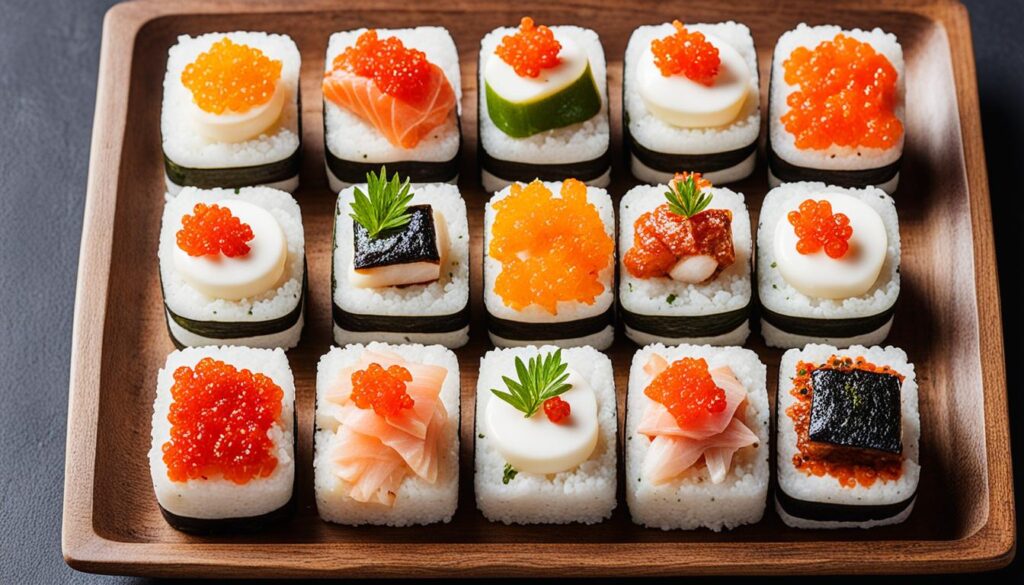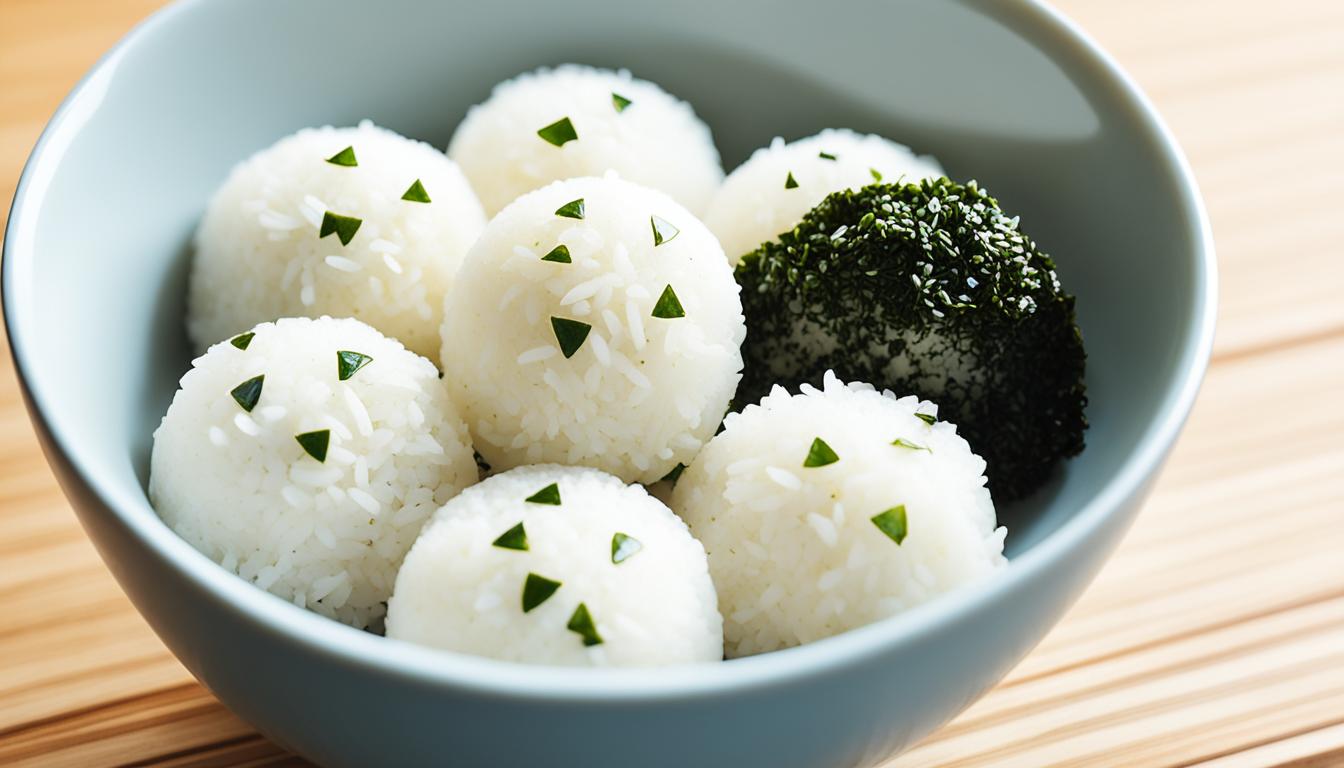Did you know that the Japanese consume an astounding 1.5 billion onigiri, or rice balls, each year? These compact, portable snacks have become a beloved part of Japanese cuisine, transcending their humble origins as a practical food for travelers and laborers. Onigiri, also known as omusubi, are a delightful culinary treat that have captured the hearts and taste buds of people around the world.
In this comprehensive guide, we’ll explore the history, preparation, and diverse flavors of these iconic Japanese rice balls. Onigiri are a staple in Japanese cuisine, enjoyed as a quick meal, picnic food, or lunchbox staple. They can be filled with a variety of savory ingredients like umeboshi (pickled plum), okaka (bonito flakes), and tuna mayonnaise, making them a versatile and delicious option.
With their charming triangular shape, onigiri have become an integral part of Japanese food culture, frequently appearing in anime, manga, and other media. Join us as we delve into the world of onigiri japanese rice balls, musubi, and the rich culinary traditions that have made them a beloved japanese cuisine staple.
What are Onigiri Japanese Rice Balls?
Onigiri, also known as omusubi or nigirimeshi, are Japanese rice balls made from steamed short-grain japanese rice. The rice is typically shaped into a triangular, cylindrical, or round form, often wrapped in a sheet of nori seaweed. Onigiri can be enjoyed plain with just a light salting, or they can be filled with a variety of savory ingredients like salted salmon, pickled plum, or bonito flakes.
Definition of Onigiri
Onigiri are a beloved japanese rice balls that have become an iconic part of Japanese food culture. These portable japanese food items are a staple in bento lunch boxes, picnics, and everyday meals, often appearing in anime, manga, and other media.
Origins and History of Onigiri
Onigiri have a long history as a portable, preserved food in Japan. Before modern refrigeration, onigiri were invented as a way to transport fresh rice for travelers, soldiers, and farmers. The rice would be compacted into a shape that could be easily carried, and the filling would help preserve the rice. Over time, onigiri evolved from a practical food to a beloved cultural staple, appearing in many Japanese stories, anime, and media.
Cultural Significance of Onigiri
Onigiri hold deep cultural significance in Japan, representing comfort, nostalgia, and the country’s food traditions. The rice balls are a staple in bento lunch boxes, picnics, and everyday meals, often appearing in anime, manga, and other media as a quintessential japanese food. Onigiri evoke memories of childhood, home-cooked meals, and the strong connection between food and cultural identity in Japan.
onigiri japanese rice balls
The two main ingredients for making classic onigiri are short-grain Japanese rice and nori seaweed. Japanese short-grain rice, also known as sushi rice, provides the perfect sticky and chewy texture for onigiri. Nori seaweed is traditionally used to wrap the rice balls, adding a savory, umami flavor. Optional fillings like umeboshi (pickled plum), okaka (bonito flakes), and tuna mayonnaise can also be added to the center of the onigiri.
Ingredients for Making Onigiri
We can shape onigiri by hand or with the help of a special onigiri mold. To shape by hand, we lightly wet our palms and add a pinch of salt. We then scoop up a portion of warm, cooked rice and gently press it into a triangle, ball, or cylinder shape. Some home cooks get creative, molding the rice into fun animal or character shapes. Onigiri molds provide a quick and easy way to achieve consistent triangular or cylindrical forms. Regardless of the shaping method, the key is to apply gentle pressure to avoid compacting the rice too tightly.
How to Shape and Mold Onigiri
We can shape onigiri by hand or with the help of a special onigiri mold. To shape by hand, we lightly wet our palms and add a pinch of salt. We then scoop up a portion of warm, cooked rice and gently press it into a triangle, ball, or cylinder shape. Some home cooks get creative, molding the rice into fun animal or character shapes. Onigiri molds provide a quick and easy way to achieve consistent triangular or cylindrical forms. Regardless of the shaping method, the key is to apply gentle pressure to avoid compacting the rice too tightly.
Versatile Fillings for Onigiri
Onigiri can be filled with a variety of savory ingredients that complement the plain steamed rice. Some of the most common traditional Japanese onigiri fillings include:
- Umeboshi (Japanese pickled plum) – provides a salty, tangy flavor.
- Okaka (bonito flakes moistened with soy sauce) – a savory, umami filling.
- Shake (salted salmon) – a classic protein-packed option.
- Kombu (simmered kelp) – adds a subtly sweet, earthy taste.
- Tuna mayonnaise – a creamy, protein-rich filling.
Creative Filling Ideas
While traditional fillings are delicious, the possibilities for onigiri fillings are endless. We can get creative by using up leftover ingredients from other meals, such as:
- Chicken karaage (Japanese fried chicken)
- Shrimp tempura
- Takikomi gohan (mixed rice)
- Corn rice
The sky’s the limit when it comes to onigiri fillings – from spicy tofu to pickled vegetables, the options allow for endless flavor combinations. Onigiri make a great addition to bento boxes, picnics, and on-the-go snacking.

Serving and Enjoying Onigiri
When it comes to serving and enjoying onigiri, we have a few tips to help you savor these delightful Japanese rice balls. Onigiri can be enjoyed at room temperature or slightly warmed, making them a convenient and versatile snack or meal. For the crispiest nori wrapping, it’s best to wrap the rice balls right before serving. However, if you’re on-the-go, pre-wrapped onigiri can also be found in many Japanese convenience stores and shops.
If you prefer your onigiri warm, you can briefly reheat them on a griddle or in a toaster oven. This will help warm the rice and crisp up the nori, creating a satisfying texture. Whether you enjoy your onigiri plain, filled with traditional ingredients like umeboshi or okaka, or get creative with unique fillings, these portable snacks are sure to capture the essence of traditional Japanese cuisine.
Onigiri are a delightful and versatile way to savor the flavors of Japan. With their convenient shape, diverse filling options, and the ability to be enjoyed at various temperatures, onigiri make the perfect accompaniment to your day, whether you’re packing them for a picnic, grabbing them on the go, or serving them as part of a larger Japanese-inspired meal.
